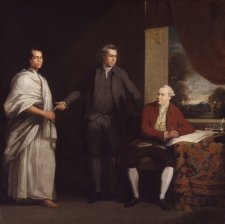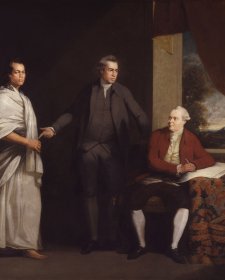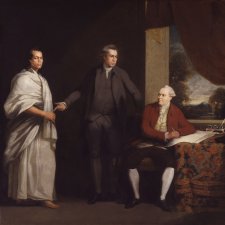- About us
- Support the Gallery
- Venue hire
- Publications
- Research library
- Organisation chart
- Employment
- Contact us
- Make a booking
- Onsite programs
- Online programs
- School visit information
- Learning resources
- Little Darlings
- Professional learning
Woollarawarre Bennelong (c. 1764–1813) was a young man when he encountered Britain’s first fleet in Warrane. He was then a rising warrior of the Wangal Eora, whose land flanked the southern side of the Parramatta River from present-day Darling Harbour to Homebush Bay. At age 25 he and another man, Colebee, were captured on the orders of Governor Arthur Phillip, who was under instruction to establish workable relations with Indigenous locals. Colebee soon escaped, but Bennelong adapted his existence to continue as an aide and intermediary between the Eora and the British and ultimately lived comfortably between the two cultures. Bennelong’s unlikely friendship with Governor Arthur Phillip saw him and his kinsman Yemmerrawanne travel to England in 1792. Some five years after his return to Australia, Bennelong led a clan of approximately 100 people who lived west of Ryde along the Parramatta River. He died a respected man at age fifty in January 1813.
The remarkable story of Woollarawarre Bennelong is one that resonates deeply. He was a traditional man who was, against his initial will, shown a European way of life, and became an intermediary between his clan and the colonialists … The question of how we move forward while still being connected to our culture and heritage has inspired much of my life’s work. Bennelong is in all of us, as we navigate the ancient and modern elements of our lives.
Stephen Page, Yugambeh man and Artistic Director for Bennelong, Bangarra Dance Theatre, 2017
Collection: National Portrait Gallery
Purchased with funds provided by Ross A Field 2008
Bennelong (age 34 in 1798)
Ross A. Field (11 portraits supported)



On one level The Companion talks about the most famous and frontline Australians, but on another it tells us about ourselves.



Representations of the inhabitants of the new world expose the complexities of the colonisers' intentions.



Visit us, learn with us, support us or work with us! Here’s a range of information about planning your visit, our history and more!